I have always believed that reading is one of the most amazing gifts that we can give our learners. Stories can transport us away from our reality and take us on a magical journey which allows us to visit anywhere in the world and beyond. In today’s uncertain and unprecedented times, we perhaps need this escapism more than ever!
However, the joyous gift of reading comes in some difficult-to-unwrap packaging. As humans, we are not naturally wired for print, we deal in sound. Reading also involves several simultaneous actions such as visual and auditory processes, phonemic awareness, fluency, comprehension, and more. If you add to this the fact that our children have not had the classroom delivery they would usually receive as a result of the lockdown, we have to consider if reading has become an even more challenging skill for our learners to develop.
Losses and gains
On the return to school, I have identified that in terms of reading rate, accuracy and comprehension there is a spectrum of losses and gains. Some learners have made huge progress whilst continuing to read at home, some have plateaued and others have regressed. Losses have included:
- A widening of the vocabulary gap
- Lack of fluency due to lack of practice
- Lost concepts about print
- Accuracy has dipped as words were ‘forgotten’
- Comprehension became harder
- A loss of passion – reading became a battle!
On the flip side there have been some positive gains:
- New authors and genres were discovered
- Reading became escapism - a haven away from lockdown
- Book swap boxes and EReaders have sparked new interest
- Families read together and talked about books
- Subtitles were read online for gaming and streaming
- Fluency increased
- Accuracy improved
- Vocabulary increased
- Comprehension developed
One interesting gain is the recognition of environmental print and words linked to advertising as children interacted with their locality in a different way.
How do we counteract the losses?
- Reignite an interest in reading by giving reading a real purpose, exploring your pupils’ favourite authors and genres and offering short, fun and practical activities.
- Make the invisible visible by modelling your decoding approaches and strategies to make meaning by wondering aloud.
- Develop fluency and accuracy by offering paired/peer reading approaches and rehearse tracking skills.
- Improve understanding by working with pictures to develop comprehension skills and then apply these to text.
- Make sure that you have a secure baseline and evidence base to support teaching and learning choices and to measure progress.
We need to become reacquainted with who has which skills and set up an early alert system to identify any changing learning trajectories.
Use of the New Group Reading Test can provide support in gathering evidence about where we are now and where we need to go next. It can act as a useful triage to identify who may need extra support by interrogating the whole picture of a pupil as a reader.
For those that then need it, a ‘delving deeper’ approach can be taken using the York Assessment of Reading for Comprehension. This provides rich information about reading rate, accuracy and comprehension allowing us to identify exactly which skills need a boost.
All of this will help our pupils to unwrap the gift of reading. As Dr Seuss said: ‘The more that you read the more things you will know. The more that you learn the more places you’ll go.’
Cadmus Inclusive is one of our Centres of Assessment Excellence


